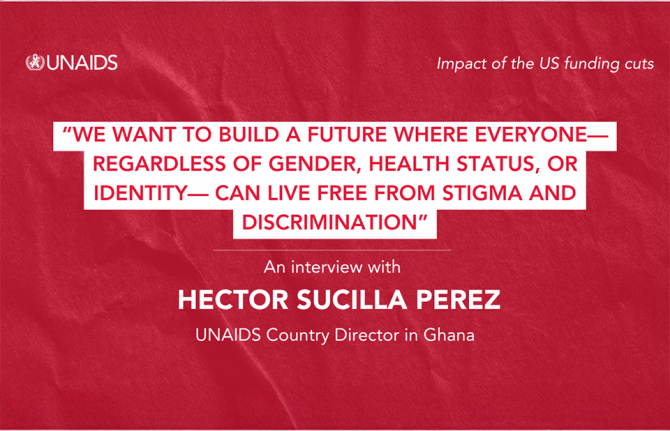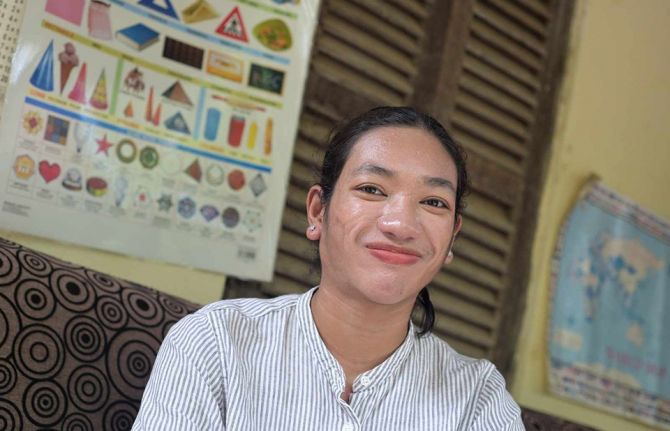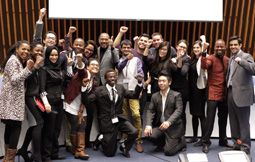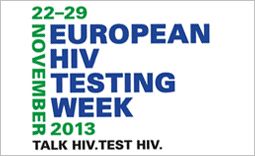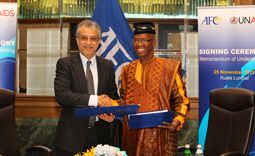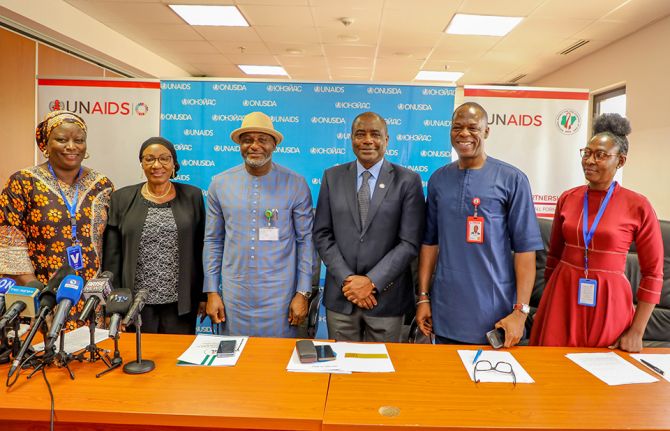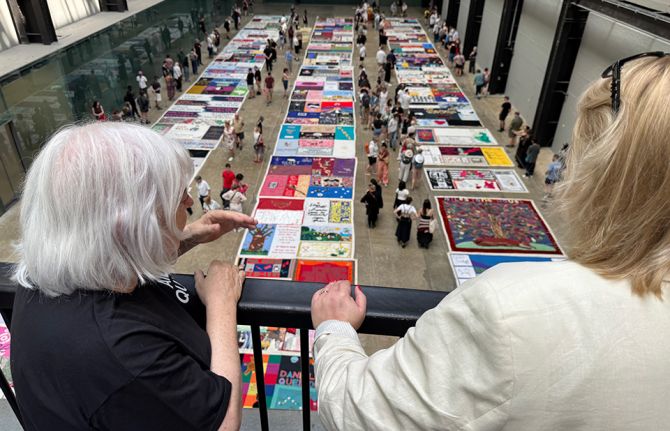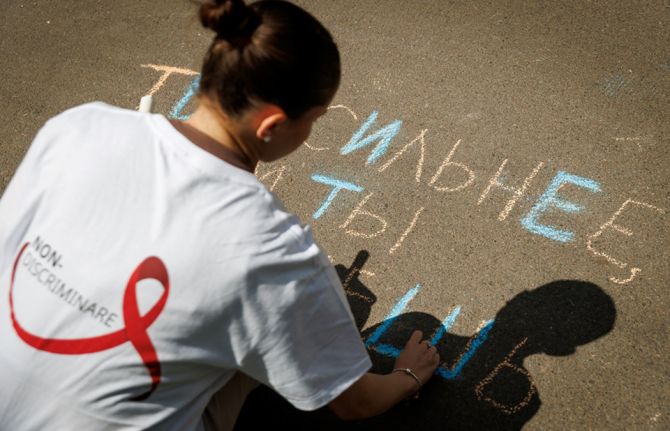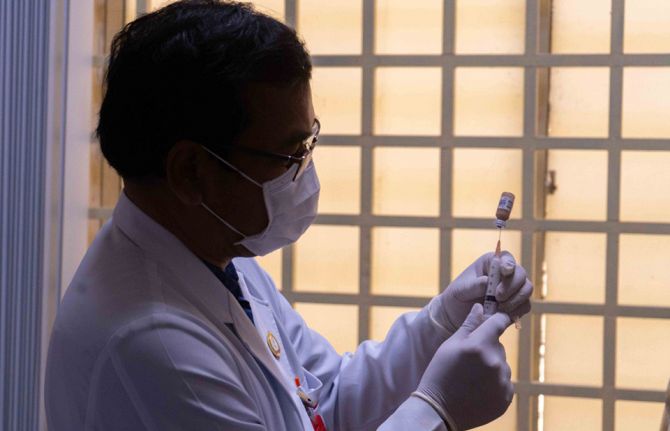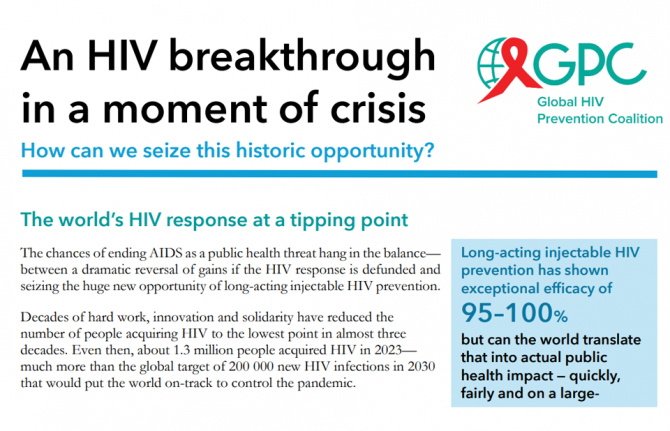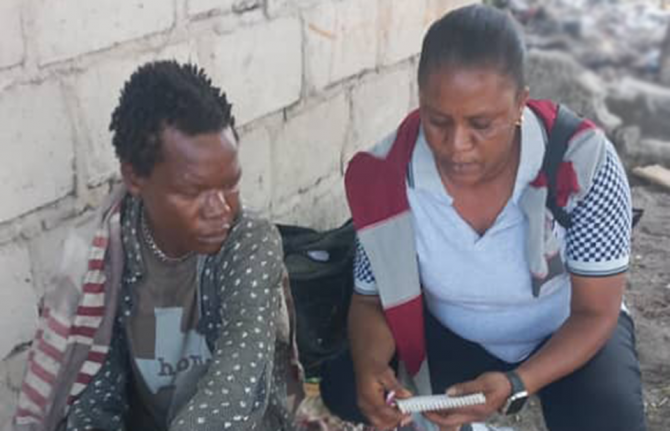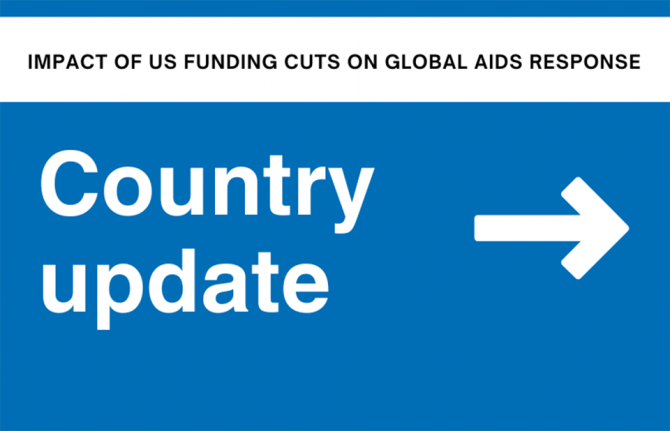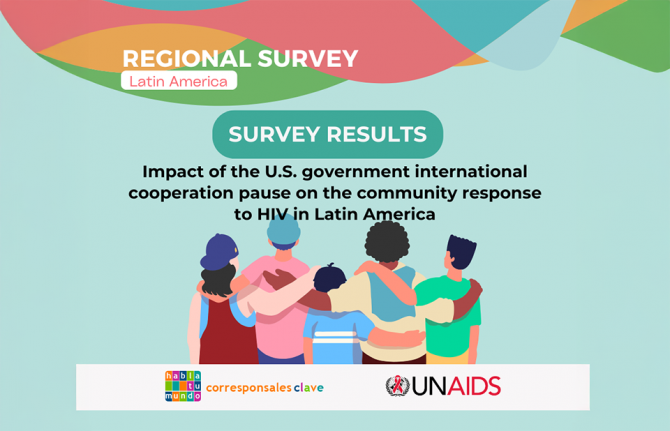
Feature Story
UNAIDS Executive Director meets Ghanaian AIDS groups
03 September 2008
03 September 2008 03 September 2008
UNAIDS Executive Director meets Ghanaian AIDS groups, 3 September 2008
Credit: UNAIDS
In Ghana attending the Accra High Level Forum on Aid Effectiveness, UNAIDS Executive Director Dr Peter Piot also visited the headquarters of the Ghana Network of Persons Living with HIV (NAP+) on 3 September where he met civil society groups active in responding to the country's AIDS epidemic.
Members from Ghana Network of Persons Living with HIV (NAP+), the Society for Women against AIDS in Africa-Ghana (SWAA) and the Centre for Popular Education and Human Rights-Ghana (CEPEHRG) shared with Dr Piot the scope of their work in the country, where, in 2007, an estimated 260,000 people were living with HIV in Ghana and 21,000 died of AIDS-related illnesses.
The three organizations work jointly and with other civil society groups to provide access to HIV prevention, treatment, care and support services and to promote the health, wellbeing and human rights of those living with HIV.

(From left): Cecilia Lodonu of SWAA Ghana chats with Dr Peter Piot UNAIDS Executive Director and Dr Leopold Zekeng UNAIDS Country Coordinator, Ghana. 3 September 2008.
Credit: UNAIDS
In the lively exchanges with Dr Piot, NAP+ members explained its role as an umbrella organization for all groups active in improving the lives of people living with HIV. SWAA, as an organization dedicated to women and their families, provided an overview of the activities it carries out in six of Ghana’s ten regions, including its "positive living toolkit", while CEPEHRG members spoke on their efforts to generate awareness around, and protect, human rights for marginalized groups, in particular men who have sex with men.
CEPEHRG's community-based outreach initiatives have received recognition both nationally and internationally - most recently at the 2008 International AIDS Conference in Mexico City, where it was singled out from other Red Ribbon Award winners for special recognition for its work with men who have sex with men.
UNAIDS Executive Director meets Ghanaian AIDS gro
External links:
Society for Women against AIDS in Africa-Ghana (SWAA)
Centre for Popular Education and Human Rights-Ghana (CEPEHRG)
Feature stories:
Assessing aid effectiveness at Accra forum (1 September 2008)
Red Ribbon Award winners honoured (7 August 2008)
Multimedia:

Feature Story
UN Secretary-General Ban Ki-moon visits UNAIDS Secretariat
01 September 2008
01 September 2008 01 September 2008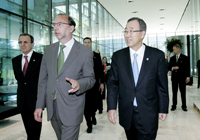
UNAIDS Executive Director Dr Peter
Piot gave the Secretary-General a
tour of the building, 31 August 2008.
Photo: UNAIDS/M. Girardin
United Nations Secretary-General Ban Ki-moon paid a visit to the UNAIDS Secretariat in Geneva on 31 August 2008.
UNAIDS Executive Director Dr Peter Piot gave the Secretary-General a tour of the building which was opened in 2006 and designed to be an inspiring work space with low impact on the environment.

Secretary-General Ban Ki-moon
and UNAIDS staff, UNAIDS Secretariat
Geneva, 31 August 2008.
Photo: UNAIDS/M. Girardin
The Secretary-General spoke of his belief in an ideal workplace that most importantly is without any sense of discrimination towards staff living with or affected by HIV and thanked members of UN Plus for broadening his horizons on this issue. He restated his personal commitment to the importance of the UN to be an enabling environment for staff living with HIV.
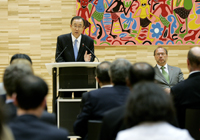
Secretary-General Ban Ki-moon
also took the opportunity to address
UNAIDS staff.
Photo: UNAIDS/M. Girardin
Secretary-General Ban Ki-moon also took the opportunity to thank UNAIDS staff for their work and Dr Piot for his commitment and dedication to stopping the spread of HIV and for being a vanguard of the global AIDS response. He also acknowledged UNAIDS is an example of UN reform in action, as through UNAIDS, UN country teams “deliver as one” on HIV.
While in Geneva, the Secretary-General marked the 20th anniversary of the United Nations Intergovernmental Panel on Climate Change (IPCC), co-recipient of last year's Nobel Peace Prize, and attended a memorial ceremony for the 19 August 2003 bombing of the UN headquarters in Baghdad.
UN Secretary-General Ban Ki-moon visits UNAIDS Se
External links:
Related

Feature Story
Assessing aid effectiveness at Accra forum
29 August 2008
29 August 2008 29 August 2008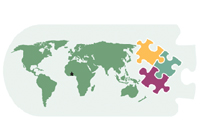
The Third High-Level Forum on Aid
Effectiveness takes place this week in
Ghana.
The Third High-Level Forum on Aid Effectiveness takes place this week in Ghana. To mark this event, we begin a new web series “Making the money work”. In coming months we will explore different aspects of aid effectiveness; how financial aid to countries can be made more effective, accountable and results-oriented.
Donors and development agencies are devoting more resources than ever to, among other development goals, the AIDS response in developing countries–welcome news for the millions of people infected and affected by the epidemic. However, many governments and organizations face significant challenges to use this aid effectively and to meet the multiple and often complex requirements of different donors. To address this, the Joint UN Programme on HIV/AIDS (UNAIDS) has taken a leading role in helping countries to "make the money work".
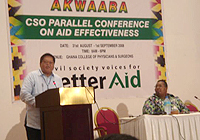
Antonio A. Tujan Jr., Chair of the
International Steering Group of the
"CSO Parallel Forum on Aid
Effectiveness", addressed the Parallel
Forum in Accra ahead of the Third
High-Level Forum, 1 September 2008.
Credit: UNAIDS
The Third High-Level Forum on Aid Effectiveness (HLF) takes place 2-4 September 2008 in Accra and will bring together ministers from over 100 countries along with donors, civil society, UNAIDS, its Cosponsors and other development agencies.
UNAIDS Executive Director Dr Peter Piot will participate as a member of the United Nations Development Group delegation.
Participants will take stock of how aid is being delivered and used, and plan and intensify efforts for improvement in aid effectiveness in the strengthening of health systems among other development goals.
“We are seeing improvements in how development aid is being planned and delivered, but results do not yet match commitments made in Paris in 2005. The AIDS response has championed more inclusive partnerships as being key and we have pioneered the principle of ownership through the 'three ones',” said UNAIDS Executive Director Dr Peter Piot.
“It has been our collective focus on AIDS results and accountability where the response has made most progress. Those results now need to be sustained. The Paris agenda sets the framework, but we must be ambitious in what we demand from the international community as we look to the future.”
Addressing flaws in aid delivery practices
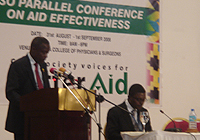
Ghana Minister of Finance and
Economic Planning, Kwadwo Baah-
Wiredu addressed the CSO Parallel
Forum on Aid Effectiveness,
1 September 2008. Credit: UNAIDS
The meeting, organized by the Organisation for Economic Co-operation and Development (OECD), the World Bank and the Government of Ghana, builds on the 2005 High-Level Forum when over 100 countries and organisations endorsed the Paris Declaration on Aid Effectiveness.
This is part of a larger movement spearheaded by organizations such as UNAIDS that started in the late 1990s when recipient countries brought forward that donors needed to support country priority setting and harmonize their approaches in order for the countries to be able to coordinate their AIDS efforts and make more efficient use of donor funding. Donors and aid agencies also progressively realized that the multiple requirements they imposed on countries drained precious resources and led to duplication of efforts.
|
The “Three Ones” principles In 2004 at a High Level Meeting in Washington, UNAIDS took the lead in endorsing the “Three Ones” principles, which call for consolidation of AIDS efforts within a country and for support for partner countries to develop:
The “Three Ones” translate the Paris Declaration into action. Rather than having resources being used in a fragmented manner, leaving many gaps, these principles enable countries to focus them for a more efficient response. |
Progress
Progress has been made in improving the alignment of global support for AIDS and in reducing the burden placed on countries and in the development and strengthening the quality of policies, institutions and processes that take the “Three Ones” principles forward.
This has resulted in improved quality and greater technical support for the development of national AIDS strategies, the mainstreaming of AIDS into development plans, development of joint UN teams on AIDS and joint programmes, and development of accountability tools. The report “Progress update and Lessons Learned from Aid Effectiveness in AIDS Responses” relates the lessons that UNAIDS has learned through its involvement in these processes.
Ghana’s experience with harmonization and coordination
Ghana is a fitting host for the Third HLF because it is a good example of harmonization in action, implementing the “Three Ones” and the recommendations of the GTT, and working towards greater alignment in its AIDS response for several years.
In 2006 Ghana established a joint UN team on AIDS, and has used participatory processes for decision-making among multiple stakeholders. This has strengthened the recognition of the Ghana AIDS Commission (GAC) as the one national authority on AIDS. It has also fostered a strong sense of national ownership of the AIDS response which led to the development of a National Strategic Framework (2006-2010) with a single National Monitoring and Evaluation Plan, developed along the lines of the key principles of the “Three Ones”.
The GAC plans to further implement these principles, in part by strengthening its partnerships with donors and by reinforcing the abilities of national actors – including community-based organizations and the private sector – to contribute in a cohesive way to the national response. It also aims to improve systems for collecting, analyzing, sharing and using AIDS data, which will lead to more evidence-informed programming which will systematically address the needs of groups at higher risk of HIV.
More work to be done
Ghana however, like many countries, still faces challenges in coordinating multiple donors, projects and processes. More coherence is needed so that the UN can “deliver as one” and help countries to scale-up their response to AIDS. The Third HLF is seen as an important opportunity to assess progress, determine next steps and step up efforts among donors, countries and UN agencies.
Assessing aid effectiveness at Accra forum
External links:
Third High Level Forum on Aid Effectiveness official web site
United Nations Development Group
Background on Third High Level Forum on Aid Effectiveness
Publications:
Enhancing results by applying the Paris Declaration at sector level: Progress update and Lessons Learnt from Aid Effectiveness in AIDS Responses (pdf, 1Mb)
The “Three Ones” principles ( en | fr | es | ru )
Related
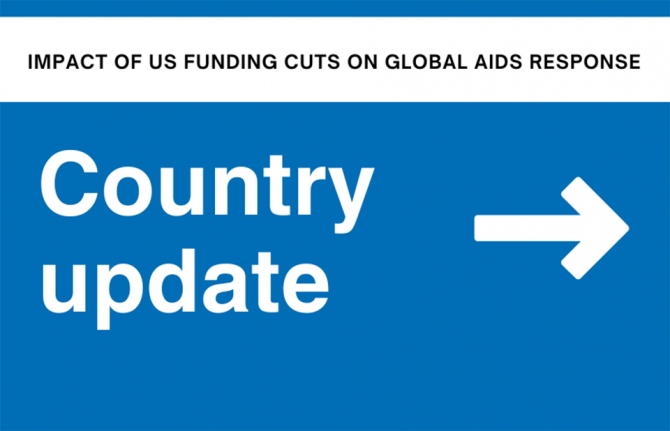 Impact of US funding cuts on HIV programmes in Ghana
Impact of US funding cuts on HIV programmes in Ghana

08 April 2025

Feature Story
People Living with HIV Stigma Index
26 August 2008
26 August 2008 26 August 2008
The survey is the result of a partnership
between IPPF, UNAIDS, GNP+ and ICW.
Much of what we know about the stigma attached to HIV and the resulting discrimination towards people living with the virus is anecdotal or fragmented. Existing surveys show that while much is known about the influence of stigma there is no clear picture of the actual magnitude of it. Stigma and accompanying discrimination are widely recognized as significant barriers to HIV prevention, treatment and care services reaching those who need them most. Without concerted action to eliminate stigma, the goal of universal access to these vital services will be impossible to achieve.
People Living with HIV Stigma Index
To address this lack of evidence, a measurement tool The People Living with HIV Stigma Index has been developed. The survey is the result of a partnership between the International Planned Parenthood Federation (IPPF), UNAIDS, the Global Network of People Living with HIV (GNP+) and the International Community of Women living with HIV (ICW). This global initiative has also received financial support from GTZ and DfID, the German and British development bodies.
With better evidence, programmes can be better directed and improved, advocacy efforts strengthened, and policy better-informed. Importantly, the initiative puts into practice the Greater Involvement of People Living with HIV/AIDS (GIPA) principle.
“It's exciting to see how interest in the Index is gaining momentum among positive networks. People are really keen to implement it in their countries and I think this is because they recognize it has been created by and for positive people, and that it can ultimately benefit their communities,” said Kate Thomson, Chief of Civil Society Partnership Team, UNAIDS.
Strengthening capacity

Much of what we know about the stigma
attached to HIV and the resulting
discrimination towards people living with
the virus is anecdotal or fragmented.
During 2008 the important process of preparing for the roll-out of the Index commenced by strengthening the capacity of networks of people living with HIV and building in-country partnerships.
From 50 countries across Asia, the Pacific, Africa, the Caribbean, Latin and South America, 87 HIV positive people, representing 66 organizations, have been trained as trainers or team leaders. UNAIDS Regional Support Teams and UNAIDS Country Coordinators as well as regional partners of IPPF, ICW and GNP+ have been working together to implement these workshops.
“When it comes to crying, shouting and speaking out against stigma—I have done it. But I have been struggling with the evidence to quantify it. As a researcher and as an advocate I now have the missing link,” said Beatrice Were from Uganda who participated in the Africa regional workshop held in Nairobi, May 2008.
The People Living with HIV Stigma Index was showcased earlier this month during a special session at the International AIDS Conference in Mexico City by Anandi Yuvaraj from ICW, “the Index gives us a real opportunity to measure, understand and advocate effectively to improve policies and programmes and to make a real difference in the lives of people living with HIV.”
National implementation
The Index has been developed in collaboration with community leaders, activists, researchers and human rights advocates around the world and piloted in Kenya, Lesotho, Trinidad and Tobago, India and South Africa. The first full-scale national implementation of the Index is underway in the Dominican Republic and findings and initial analysis will be published towards the end of 2008.
The results coming from this process will be revealing. As Andell Simon, a researcher involved in the pilot phase held in Trinidad in 2006 said, “being interviewed by another person living with HIV does make a difference as you feel that they really understand more about how you feel about things related to being HIV positive.”
For more information visit the recently launched web site www.stigmaindex.org or contact the project coordinator at IPPF, Lucy Stackpool-Moore lstackpoolmoore-at-ippf.org (replacing -at- with @).
People Living with HIV Stigma Index
External links:
People Living with HIV Stigma Index web site
Publications:
The People Living with HIV Stigma Index: User guide for teams implementing the Index in their communities (pdf, 955 kb)

Feature Story
Prevention is for life
25 August 2008
25 August 2008 25 August 2008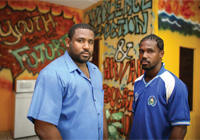
Belize: A programme coordinator with a
former gang member now actively involved
in HIV prevention and violence reduction
programmes. Credit: Carina Wint/UNFPA
HIV prevention is about saving lives. UNAIDS cosponsor, the United Nations Population Fund (UNFPA), has published an advocacy booklet telling the personal stories of people and communities who are making a difference in many corners of the world. "Prevention is for Life" puts a human face to these prevention efforts by telling real stories and accompanied by stunning photography.
In recent years, we have seen a substantial increase in HIV prevention efforts, and they are producing results in a number of heavily affected countries. However, the AIDS epidemic is not over in any part of the world—for every two people accessing HIV treatment, five are newly infected. HIV requires a long term response that is grounded in evidence and human rights.
The booklet starts with the story of how HIV peer education projects in street gangs in Belize are empowering young people to take responsibility within the youth community. In another corner of the world, Yulia is a young HIV-positive mother in Moscow struggling with stigma as well as the health impact of HIV but in her story she is hopeful for a brighter future for the next generation.

Tajikistan: Two young women share a
tender moment at UNFPA-sponsored Guli
Surkh, an NGO located in Dusnabe. Credit:
Warrick Page/UNFPA/Panos Pictures
A story of a micro-credit project in Tajikistan illustrates the connection between poverty, gender inequality, and vulnerability to HIV. With access to the micro-credit, migrant wives can gain financial independence and support their families. Again, it underlines that HIV is a development and human rights issue.
In China, messaging and condom promotion campaigns have been launched reaching out to the country’s large migrant population. In Egypt, HIV prevention services are reaching people who risk exclusion as mobile clinics and voluntary counselling and testing services are delivered to people living in Cairo’s poorest neighbourhoods.
Although HIV information, counselling, services and commodities such as male and female condoms are not revolutionary prevention concepts, ensuring access to these prevention tools is a challenge. This booklet shows vividly that it’s a challenge worth taking on as access to HIV prevention is making a real difference in people’s lives.
Prevention is for life

Feature Story
MTV Staying Alive Foundation grants
19 August 2008
19 August 2008 19 August 2008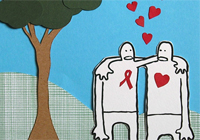 The MTV Staying Alive Foundation invites grant applications from youth-led organizations and young people who are working on HIV prevention and AIDS education campaigns within their communities
The MTV Staying Alive Foundation invites grant applications from youth-led organizations and young people who are working on HIV prevention and AIDS education campaigns within their communitiesThe MTV Staying Alive Foundation invites grant applications from youth-led organizations and young people (aged between 15-27 years) who are working on HIV prevention and AIDS education campaigns within their communities.
The deadline for December 2008 proposals is the 15th September 2008, and successful applicants will be announced on World AIDS Day, 1 December 2008. Young people, 15–24 years of age, accounted for around 45% of all new HIV infections in 2007 and many young people lack accurate, complete information on how to avoid exposure to the virus. The Staying Alive Foundation (SAF) believes that the information geared towards young people is one of the keys to helping prevent HIV infection and that young people can bring about positive social change around HIV prevention, if given the opportunity.
A Staying Alive Award comes with a financial grant up to US$ 12,000, Staying Alive materials (including MTV Staying Alive programming and teaching kits), a small fund to buy technical media equipment, a local mentor and a personal grant manager.
About Staying Alive
In 1998, MTV launched the Staying Alive campaign, a multimedia global HIV prevention campaign to challenge AIDS-related stigma. UNAIDS has partnered with MTV, providing funding and technical assistance on key AIDS issues.
Following the success of the campaign, the Staying Alive Foundation (SAF) was set up in 2005 to support young people around the world who are working in AIDS awareness, education and prevention campaigns among their peers. To date they have given 100 grants to 81 projects across the globe.
If you have any further questions then email at foundation@staying-alive.org
MTV Staying Alive Foundation grants
Feature stories:
MTV launches ‘Staying Alive’ website (29 November 2007)
Getting involved is good for business (22 January 2007)
External links:
Staying Alive Foundation web site
December 2008 Staying Alive Awards Funding Criteria
December 2008 (ref: (6/08) Staying Alive Awards Application Guidelines
Frequently Asked Questions
Success stories of former Staying Alive grant winners
Related
 “Who will protect our young people?”
“Who will protect our young people?”

02 June 2025

Feature Story
The power of two wheels
18 August 2008
18 August 2008 18 August 2008
Yvonne Awuor, a volunteer home-based
care provider with Women Fighting AIDS in
Kenya (WOFAK) takes a bicycle taxi to visit
her clients in remote villages.
Credit: WOFAK
Before she sets out to visit her client Ms. Heluda in Kisian, Yvonne prepares a bag with a towel, multivitamin tablets, over-the-counter painkiller tablets, a packet of porridge flour, liquid detergent, hand gloves and soap. Then, she takes a bicycle taxi to Kisian village, 12 km away.
On her arrival at Ms. Heluda’s home Yvonne is met by three young children who are not in school today because their mother was too sick to get up this morning and has been too weak to cook for them, she is HIV-positive.
Yvonne Awuor is a volunteer home-based care provider in Kenya with WOFAK (Women Fighting AIDS in Kenya) an organization founded by women to give support and reach out to other women experiencing discrimination as a result of being affected by or infected by HIV.
Yvonne talks with Ms. Heluda and makes the fire to prepare porridge for her and the children. She then helps her to take the cup of porridge, perhaps her only food intake that day and bathes her face, hands, feet and body. She applies massage oil and massages her feet, hands and shoulders. After chatting with her about the importance of taking care of herself and the need to take her HIV medications so that she will get stronger, Yvonne later returns to town by bicycle taxi, promising to visit again in three days time.
Home-based care ensures a continuum of care for people living with HIV who have left hospital and returned home. It offers a holistic approach often including palliative and spiritual care. However, in most areas, providing care for people living with HIV would be far more difficult and in many cases impossible without a bicycle.
“We use bicycles in Kisumu because it is the cheapest means of transport for our caregivers. We also use the bicycle as it offers a more convenient way of reaching remote places within our area”, says Dorothy Onyango, Director of WOFAK. “In many cases, our caregivers are one of the best sources of hope and inspiration for the sick person and the family members. Such visits are therefore received with joy,” she added.
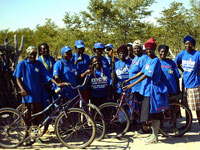
Home-based care volunteers from Okathitu
Parish, part of the Anglican AIDS
programme in the country (2006).
Credit: BEN Namibia
In Namibia, the non-governmental organization Bicycling Empowerment Network (BEN) was set up to respond to the need for affordable transport by providing bicycles and maintenance training to home-based care volunteers. Through field research they found that in this vast country rural Namibians have extremely poor access to emergency medical transport and that the cost and non-availability of transport has a particularly negative impact on adherence to antiretroviral treatment for people living with HIV.
“Bicycles benefit the caregivers, clients and their families,” says Michael Linke, Director, BEN Namibia.
In urban settings with good roads, bicycles can increase the range and carrying capacity of people by four or five times compared with walking. Even on un-tarred rural tracks a bicycle carries up to four times the weight, goes twice as far and travels twice as fast as a person walking.
However according to Linke a bicycle is much more than a practical mode of transport.
“Both volunteers and clients have told us that their sense of pride in the home-based care service increases when the volunteer has a bicycle to make her visits. We didn’t expect that a bicycle would also affect the clients’ perception of the services.”
In addition to bikes for delivering home-based care, BEN Namibia has also purchased 93 bicycle ambulances to take people over what are often long distances to the nearest health clinics and so improving access to healthcare for people living with HIV.
In countries like Kenya and Namibia the volunteers who bring home-based care services to people living with HIV form the backbone of the response to AIDS. Bicycles are playing an important role enabling them to visit clients more often, spend longer with them, deliver more supplies including antiretroviral treatment, and reach more distant locations.
The power of two wheels
Related

Feature Story
HIV prevention in Olympic Villages
14 August 2008
14 August 2008 14 August 2008
With support from UNAIDS, 2 public service
announcements broadcast in English,
French and Chinese are being shown in
waiting area in Olympic Polyclinic. These
feature German soccer player and UNAIDS
Special Representative Michael Ballack,
and Chinese Basketball player Yao Ming.
Credit: UNAIDS
As part of a joint HIV prevention campaign, some 100,000 high-quality condoms are being made available to athletes free of charge in health clinics in the Olympic Villages of Beijing, Qingdao and Hong Kong. Athletes are also able to find useful information on HIV from thousands of posters and leaflets in English, French and Chinese.
In the waiting room of the polyclinics, HIV prevention videos with UNAIDS Special Representative and German footballer Michael Ballack and Chinese basketball star Yao Ming are being shown in three languages. In addition, all athletes competing in the 2008 Olympic Games have received flash sticks that include fact sheets on HIV.
These HIV prevention and anti-discrimination efforts are part of the 2008 Olympics HIV campaign “Play safe – Help stop HIV” launched by UNAIDS, International Olympic Committee (IOC), and the Beijing Organizing committee of the Olympic Games (BOCOG). The objective of the campaign is to educate athletes participating in the Beijing Games about HIV and encourage them to be ambassadors of AIDS response.
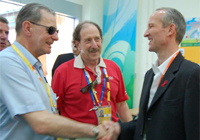
IOC President, Dr. Jacques Rogge (left)
greets Dr. Bernhard Schwartländer, UNAIDS
Country Coordinator (centre) during the
launch of the Beijing Olympics HIV and
AIDS Campaign "Play safe – Help stop HIV".
Credit: UNAIDS
“Athletes should know about how HIV can be transmitted, how it does not transmit and how HIV can be prevented. This will help them educate their peers and fight discrimination against people with HIV. It really is a topic relevant to sport,” said Campaign Ambassador and Egyptian swimmer Rania Elwani.
The campaign not only aims to benefit the many athletes taking part but also members of the national delegations and the more than 100,000 volunteers.
Today about 33 million people are living with HIV worldwide. Young people, 15–24 years of age, account for around 45% of all new HIV infections in 2007. However, many young people still lack accurate, complete information on how to avoid exposure to the virus.
Many young people are involved in sport, either as spectators or participants. Through this global sport gala of the Beijing Olympics, messages about AIDS can reach out to communities, especially to youth, to promote safer sexual behavior and to stop stigma and discrimination.

The objective of the 2008 Olympics HIV
campaign “Play safe – Help stop HIV” is to
educate athletes participating in the
Beijing Games about HIV and encourage
them to be ambassadors of AIDS response.
Credit: UNAIDS
“Famous athletes can play an important role to bring across messages about HIV prevention, care and support as they are regarded as role models by young people," said IOC President Jacques Rogge. UNAIDS Country Coordinator Dr Bernhard Schwartländer said, “We know that sport and the Olympic Games are universal languages that can play a very important and positive role in raising AIDS awareness and reducing stigma and discrimination of people living with HIV.”
In 2004, UNAIDS signed a Memorandum of Understanding with the IOC, combining efforts to enhance the role of sports organization in the AIDS response at community and national levels, and to organize AIDS awareness activities with coaches, athletes and sport personalities.
HIV prevention in Olympic Villages
Partners:
International Olympic Committee: HIV/AIDS prevention and promotion of healthy lifestyles programme
Press centre:
IOC and UNAIDS join forces to engage sport community in fight against AIDS (1 June 2004)
Feature stories:
When red ribbon meets Olympics (11 August 2008)
Olympics 2008: AIDS awareness training for young volunteers in China (25 June 2008)
Carrying the Olympic flame for PLHIV in Tanzania (18 April 2008)
Planting trees for AIDS in China (27 June 2007)
China’s Olympic effort to raise AIDS awareness (12 September 2006)
External links:

Feature Story
When red ribbon meets Olympics
11 August 2008
11 August 2008 11 August 2008
More than 200 workers gather at an
awareness activity on an Olympic c
onstruction site in Beijing. AIDS-related
pamphlets, posters, playing cards and
condoms were distributed and workers were
able to find out information about HIV and
how to protect themselves and others,
September 2006. Credit: UNAIDS
A range of initiatives by UNAIDS in China in partnership with the Chinese Government and the International Olympic Committee (IOC) in the run-up to the 2008 Games illustrate how sport can break down barriers, fight discrimination and make a difference in the AIDS response.
China’s Olympic effort to raise AIDS awareness
Long before the athletes from all over the world gathered to share dreams at the Olympic Games, tens of thousands of builders have been working hard on construction sites around Beijing to prepare for the event. Many of the people working on sites such as the famous Olympic Stadium, the Bird’s Nest are migrant workers.
Migrant workers are particularly vulnerable to HIV as they are often far away from their families for prolonged periods of time.
In a bid to address the needs of migrant workers in the run up to the Olympics, the Chinese AIDS/STD Prevention and Control Foundation and the Beijing Health Bureau, in conjunction with UNAIDS, rolled out an AIDS awareness campaign at more than 20 Olympic sites over a six month period prior to the games.
Planting trees for AIDS in China

UNAIDS Special Representative Her Royal
Highness Princess Mathilde of Belgium
joined the symbolic tree planting event led
by organizations of people living with HIV
in China, 27 June 2007 Credit: UNAIDS
Many people living with HIV actively participated in Beijing’s preparation to host the Olympics Games. They have put a human face to the AIDS epidemic and helped reduce discrimination and stigma.
The Beijing Health Bureau in collaboration with local HIV advocacy groups ran a year long project where trees were planted and watered and small plates with names were tied to the trees. This initiative can trace its history back to 2006 when a group of people living with HIV decided to get more involved in public events and reduce AIDS-related stigma and discrimination.
UNAIDS and UNICEF Special Representative Her Royal Highness Princess Mathilde of Belgium joined one such tree planting event in 2007. Her Highness said: “You are showing us the way, working together to make Beijing greener for the well-being of all.”
Carrying the Olympic flame for people living with HIV in Tanzania
Beyond China, Dhamiri Mustapha, a young Tanzanian woman living with HIV was one of the 80 dignitaries who carried the Olympic flame during the five-kilometre torch relay in Dar Es Salaam, Tanzania, in April this year.
The twenty-three-year old woman showed extraordinary courage by taking part in this high-profile event in her own country. She spoke openly about the importance of condom use and urged young people to protect themselves.
In a joint message, IOC President Jacques Rogge and Dr Peter Piot Executive Director of UNAIDS, underlined how sport can break down barriers, fight discrimination and make a difference in the AIDS response. "Sport offers a perfect platform to make young people aware of the issue, to promote preventive messages, and to ensure that people living with HIV are not discriminated against. Discrimination towards a country, or a person on grounds of race, religion, politics, gender, or otherwise, is incompatible with the principles of the Olympic Movement.”
Olympics 2008: AIDS awareness training for young volunteers in China

Fun and games during HIV training at
Beijing Modern Vocational and Technical
College, June 2008. Credit: UNAIDS
Games have begun and as Ambassadors of the host city, young Olympic volunteers are welcoming international guests to Beijing.
As part of their preparation for the Beijing Olympic and Paralympic Games, around 7,500 volunteers at 13 universities have learned knowledge and skills on HIV prevention and how to counter discrimination through games, presentations, quizzes and interactive question and answer sessions. In parallel, 100, 000 volunteers received a basic information package on HIV before the Games.
People living with HIV participated in the training session as trainers. Their presence helped to eliminate false ideas and preconceptions about people living with HIV.
The Olympic volunteer training programme was convened by UNAIDS and United Nations Volunteers (UNV) and implemented in collaboration with the United Nations system in China, Beijing Youth League, Red Cross Society of China and Marie Stopes International (MSI) China.
The role of sport
UNAIDS and the International Olympic Committee have been working closely together since 2004 when they signed a Memorandum of Understanding in which both organizations agreed to combine their efforts to raise awareness about HIV.
When red ribbon meets Olympics
Partners:
International Olympic Committee: HIV/AIDS prevention and promotion of healthy lifestyles programme
Press centre:
IOC and UNAIDS join forces to engage sport community in fight against AIDS (1 June 2004)
Feature stories:
Olympics 2008: AIDS awareness training for young volunteers in China (25 June 2008)
Carrying the Olympic flame for PLHIV in Tanzania (18 April 2008)
Planting trees for AIDS in China (27 June 2007)
China’s Olympic effort to raise AIDS awareness (12 September 2006)
External links:

Feature Story
AIDS 2008 closes in Mexico
08 August 2008
08 August 2008 08 August 2008 The XVII International AIDS Conference has ended in the Mexican capital today after five days of spirited participation involving an estimated 22,000 people engaged in the global response to AIDS.
The XVII International AIDS Conference has ended in the Mexican capital today after five days of spirited participation involving an estimated 22,000 people engaged in the global response to AIDS.Leaders, policymakers, academics, scientists and activists from around the world descended on Mexico City from 3-8 August 2008 to assess progress in the AIDS response and to identify future priorities in scaling up global efforts to stop the HIV epidemic.
Under the theme “Universal Action Now!”, AIDS 2008 has called for a renewed commitment from the international community to strengthen the scale up of HIV prevention, treatment, care and support programmes worldwide, with the aim to provide universal access to these services by 2010 and to work towards achieving the Millennium Development Goals – which includes the target of halting the spread of HIV by 2015.
Preventing the transmission of HIV received significant focus during the five-day conference, as participants contributed to sessions that addressed the complexity of the epidemic and underlined the importance of “knowing your epidemic and knowing your response”. HIV prevention successes and failures to date were analyzed, leading to a greater understanding that “combination prevention” is as necessary as “combination treatment” when it comes to stopping the HIV epidemic– because for every two people that began antiretroviral treatment last year, five became newly infected.
Providing antiretroviral treatment, combating HIV-related stigma and discrimination, strengthening health systems, finding an HIV vaccine, as well as responding to broader human rights for people living with HIV were some of the other top issues discussed at the conference, the first to be held in Latin America.
While AIDS 2008 has followed the release of the UNAIDS 2008 Report on the global AIDS epidemic, which points to significant progress in reducing new HIV infections and AIDS-related deaths in the past two years, the conference underscored the fact that AIDS is not yet over in any part of the world – a point stressed by UNAIDS Executive Director Dr Peter Piot and other leaders involved in the AIDS response.
At the very heart of the XVII International AIDS Conference was the Global Village, an area of over 8,000 square metres open to everyone including community organizations from around the world, local and national groups and the general public. Open and active discussions took place highlighting stories of grassroots victories along with the challenges that communities face and opportunities to improve their response to the epidemic.
The International AIDS Conference is the world’s largest HIV forum. It is held every two years and organized by the International AIDS Society, together with a series of partners including UNAIDS. The next conference will be in Vienna, Austria in July 2010.
AIDS 2008 closes in Mexico
Partners:
Feature stories:
Red Ribbon Award winners honoured
The Lancet: Series on HIV prevention launched
Special Session on the global financial architecture for AIDS
International AIDS Society marks 20 years
Official opening of the Global Village at AIDS 2008
AIDS 2008 opens in Mexico
Multimedia gallery:
Photo gallery of the Global Village at AIDS 2008
Photo gallery of other events at AIDS 2008
External links:
AIDS 2008 Official web site
AIDS 2010 Official web site

